Lauren Krukowski is a second-year Master of Fine Arts candidate at the University of Iowa in the United States, studying printmaking with papermaking as a secondary focus. She spent the month of June 2022 in residence at David Krut Workshop (DKW) to learn about collaborative printmaking and editioning. The University of Iowa’s Stanley Award for International Research Fellowship supported Lauren’s time in Johannesburg.

Lauren Krukowski starting to make oil based monotypes at David Krut Workshop
Spending a month at the David Krut Workshop was an extraordinary hands-on learning experience. My goals for the residency were to strengthen and expand my printmaking skills and spend time in a collaborative workshop. I was interested in experiencing how printmakers and artists work together to create, troubleshoot, and edition print projects. Throughout the month, I saw artists Vusi Beauchamp, Maaike Bakker, and Stephen Hobbs making in the workshop, and printers Kim-Lee Loggenberg, Sarah Judge, and Sbongiseni Khulu editioning artists’ work. I even experimented with new-to-me processes like oil monotypes and soft-ground etching with assistance from the DKW team of printmakers. I left the experience full of new knowledge, techniques, and a better understanding of the immense precision and organization that goes into each edition at DKW, as well as the ingenuity, flexibility, adaptability, and creativity that goes into each artist’s collaboration. I am very grateful to have had the opportunity to work side-by-side and learn from such a knowledgeable, welcoming, and hard-working team like DKW’s. Including everything I learned at DKW in one blog post is impossible, so I’ve focused on four highlights below.

Sbongiseni Khulu teaching Lauren about inks and modifiers for oil-based monotypes.
Oil Monotype, Surface, and Relief Rolls: My first week at DKW, I was lucky to work with Sbongiseni Khulu on oil-based monotypes. Sbongiseni walked me through oil-based inks and modifiers for additive and subtractive monotypes and helped me print my monotypes. The lessons I learned in oil monotype in my first week carried through my time at DKW. In my second week, I printed monotype flats in solid colors for base layer options for an ongoing project with artist Nina Torr. In my final week at DKW, I experimented with surface rolls on top of inked-and-wiped intaglio plates to create two-and three color etchings.
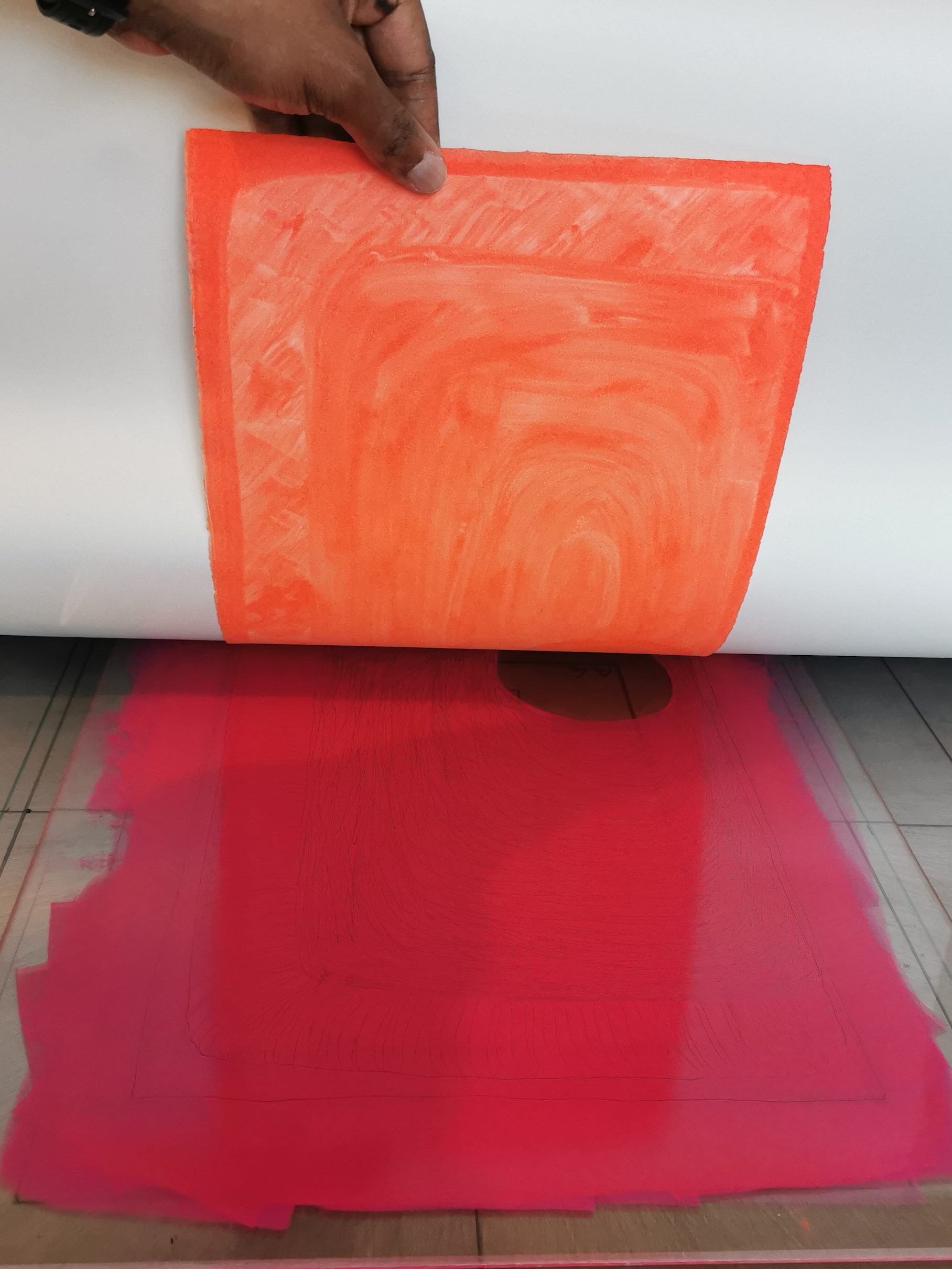
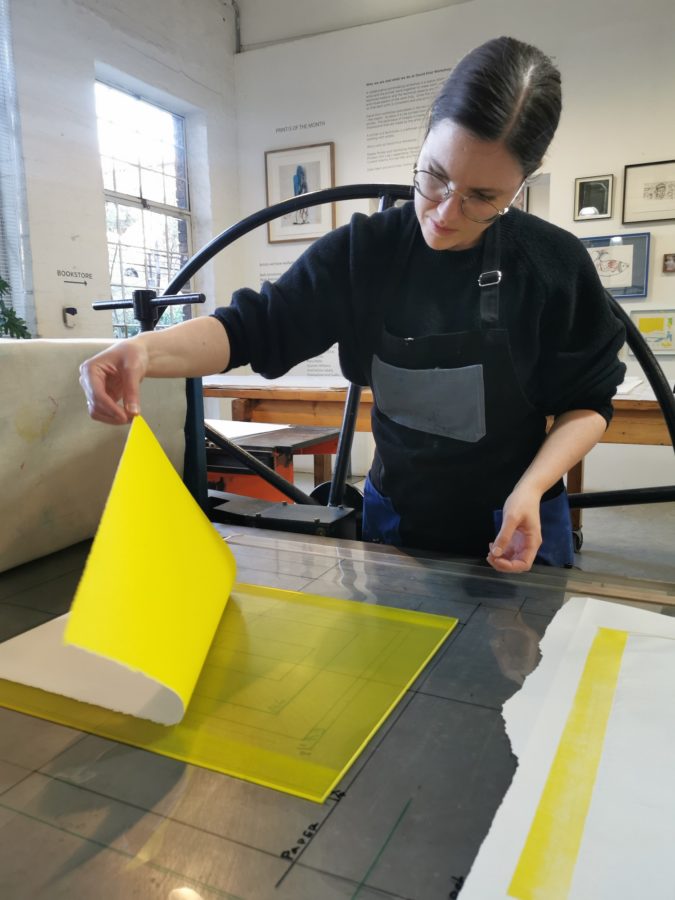
Throughout the month, I observed Sbongiseni printing layers of linocut and monotype for Mbali Tshabalala and also collaborating with Stephen Hobbs on oil-based monotypes and object prints utilising surface rolls.
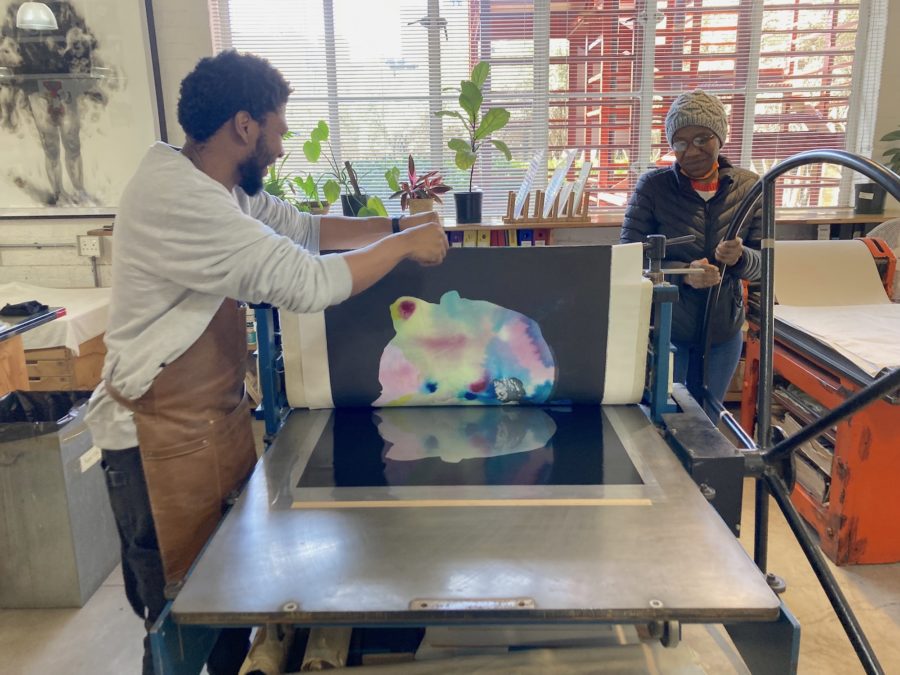
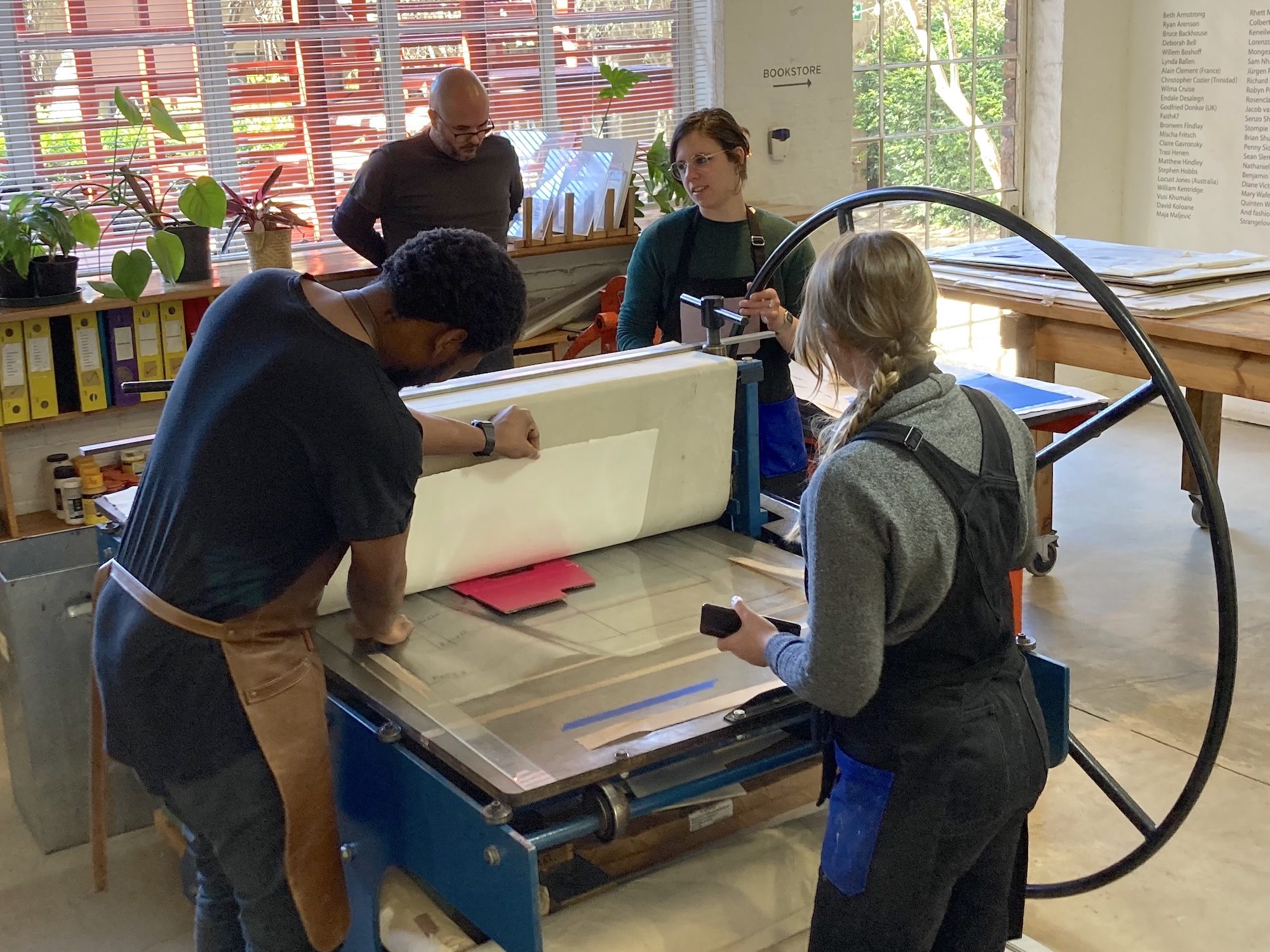
Chine-collé: Chine-collé collage is a technique I have used frequently in my work since 2018. Another highlight of my time at DKW was working with Roxy Kaczmarek to prepare Arakaji 31gsm paper with methyl-cellulose glue for Maja Maljevic’s edition “Mind Over Matter.” Although I have done this process in my own work before, Roxy helped me improve my technique. I learned how to adhere the glue slowly and more precisely for better results using the paper for intaglio printing.

Kim-Lee and Sarah printing Maja Maljevic’s etching titled “Mind Over Matter” while also adhering the screenprinted Arakaji paper as an element of chine-collé in the work.
I also was lucky to see Anna van der Ploeg’s and Maaike Bakker’s work in progress, both artists using chine-collé in different ways. I saw Sarah editioning Anna’s “Who Invited This Guy?” The edition uses Kitakata Natural paper to create a warm background tone behind Anna’s dry-point intaglio marks. A cut-out shape in the Kitakata paper leaves a negative space where the white of the backing paper shows through, creating a third “color” in the image. I was also excited to observe Sarah and Kim-Lee collaborating with Maaike Bakker, who uses printed and drawn chine-collé elements in her work in a collage-like way.
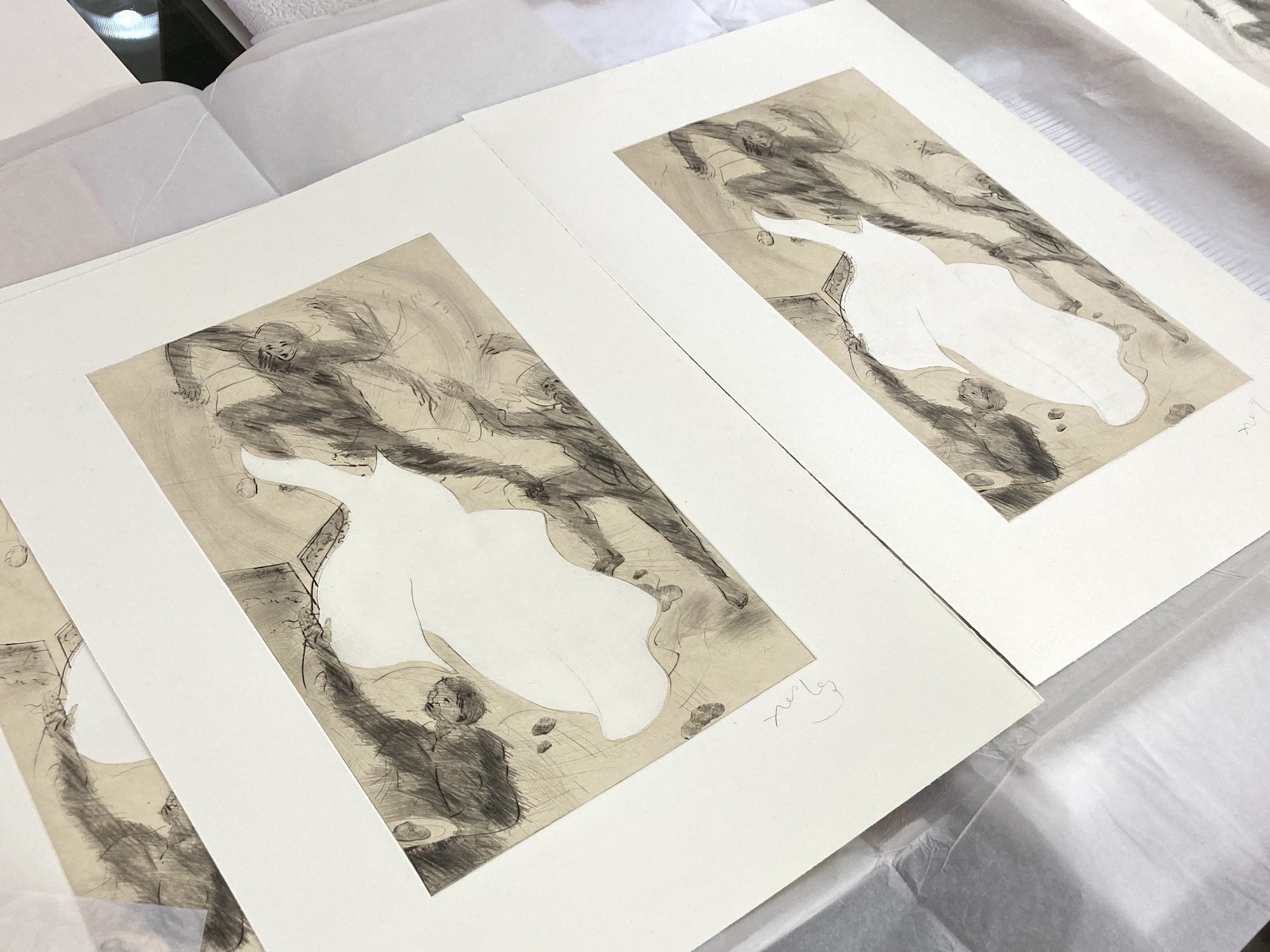
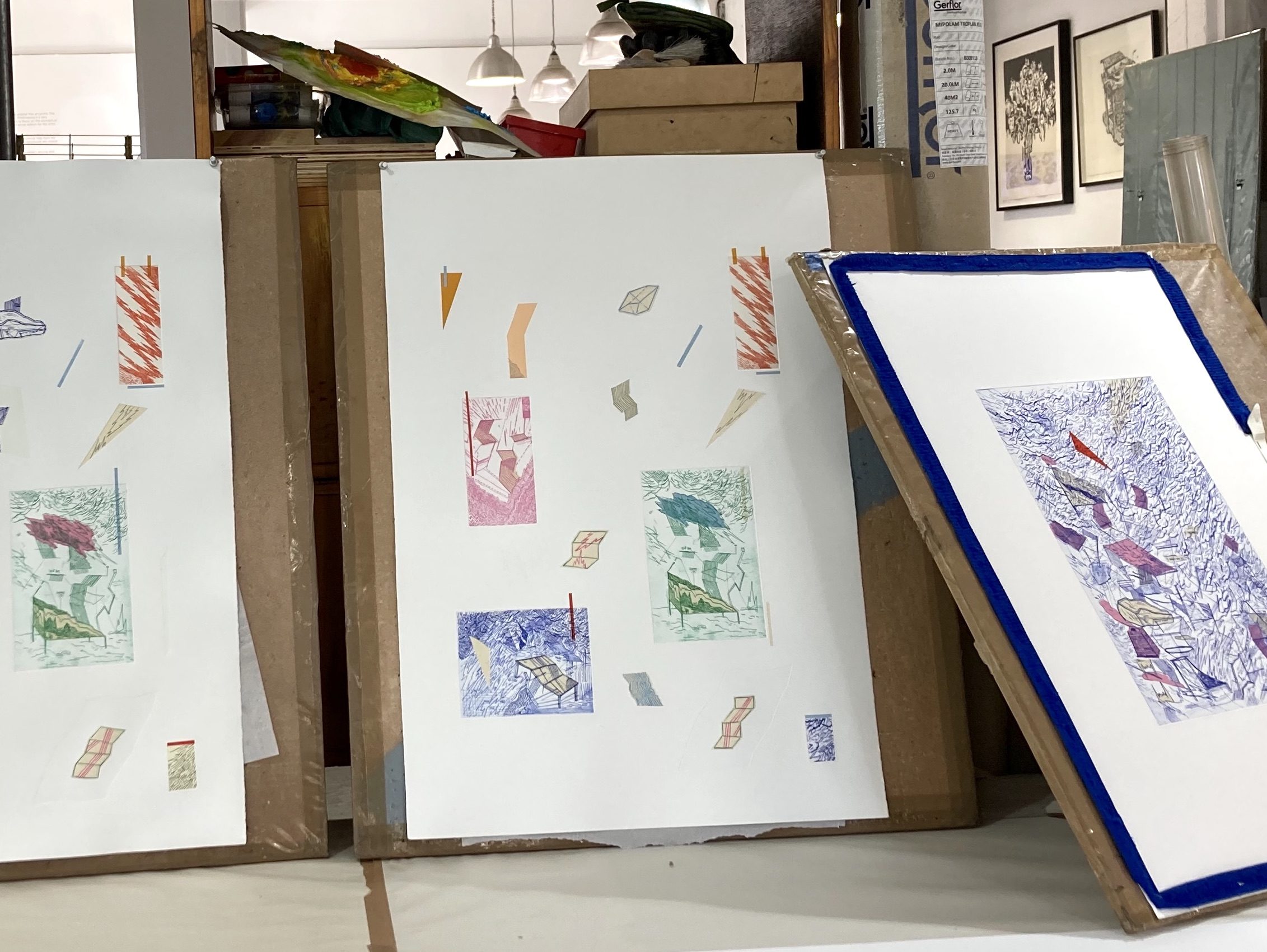

Lauren and Roxy examining one of Lauren’s inked copper etching plates
Soft-Ground: In my final two weeks, Roxy gave me a master class in how DKW does hard-ground, soft-ground, sugar-lift, aquatint, and spit-bite etchings-processes using acid and fire; in numerous ways! I was able to create three copper etching plates using these techniques and experiment with color proofing the plates with the help from Roxy and Kim-Lee. I particularly enjoyed the directness and quality of line possible in soft-ground marks. We made many color proofs to test how transparent colors layer and optically mix on the paper. I am excited to continue working with soft-ground, spit-bite, surface rolls on top of inked-and-wiped intaglio plates, and layering color in my etchings ongoing.
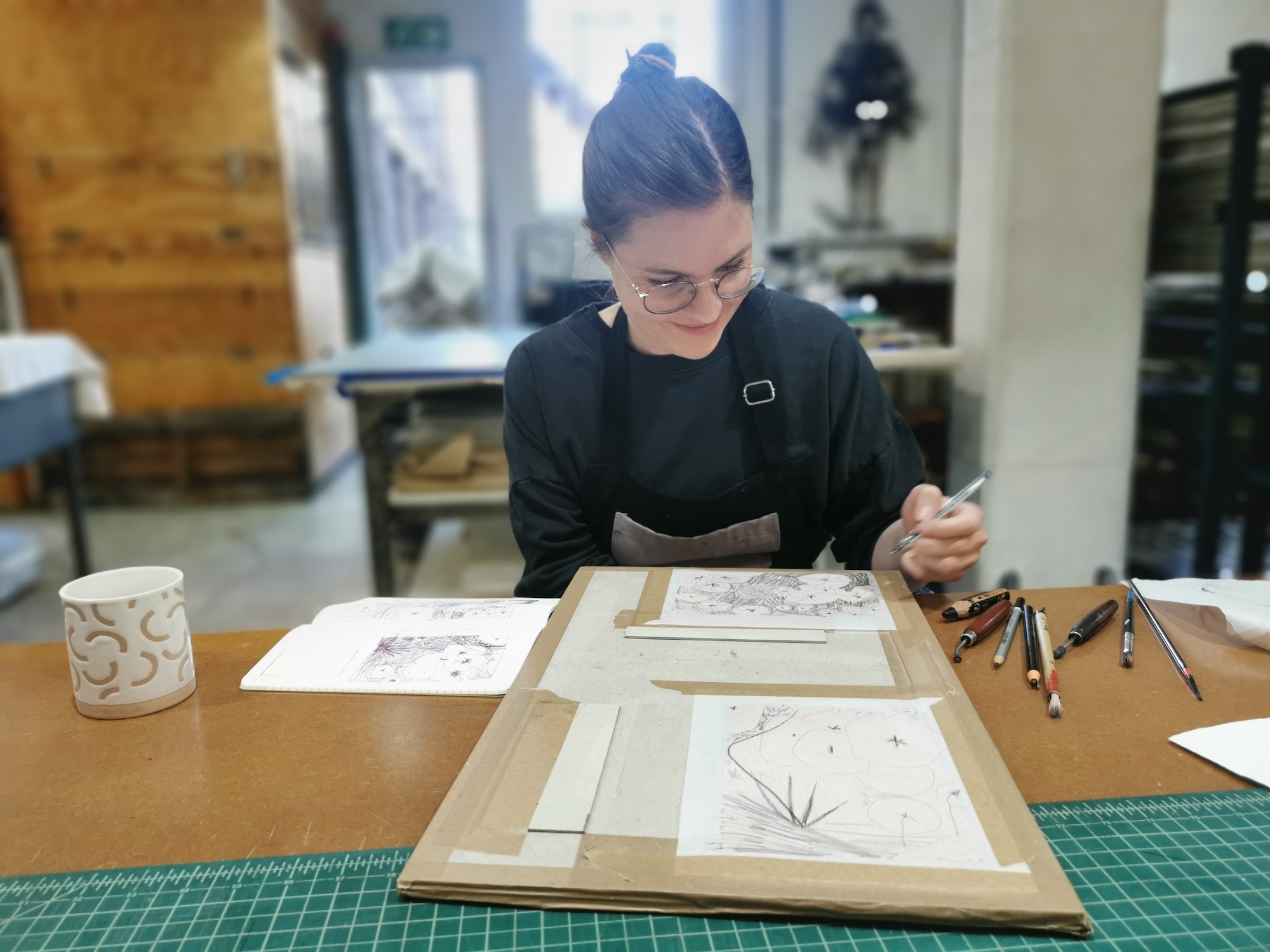
Lauren working drawing into soft-ground on a copper etching plate using pens, markers, crayons, and roulette tools.
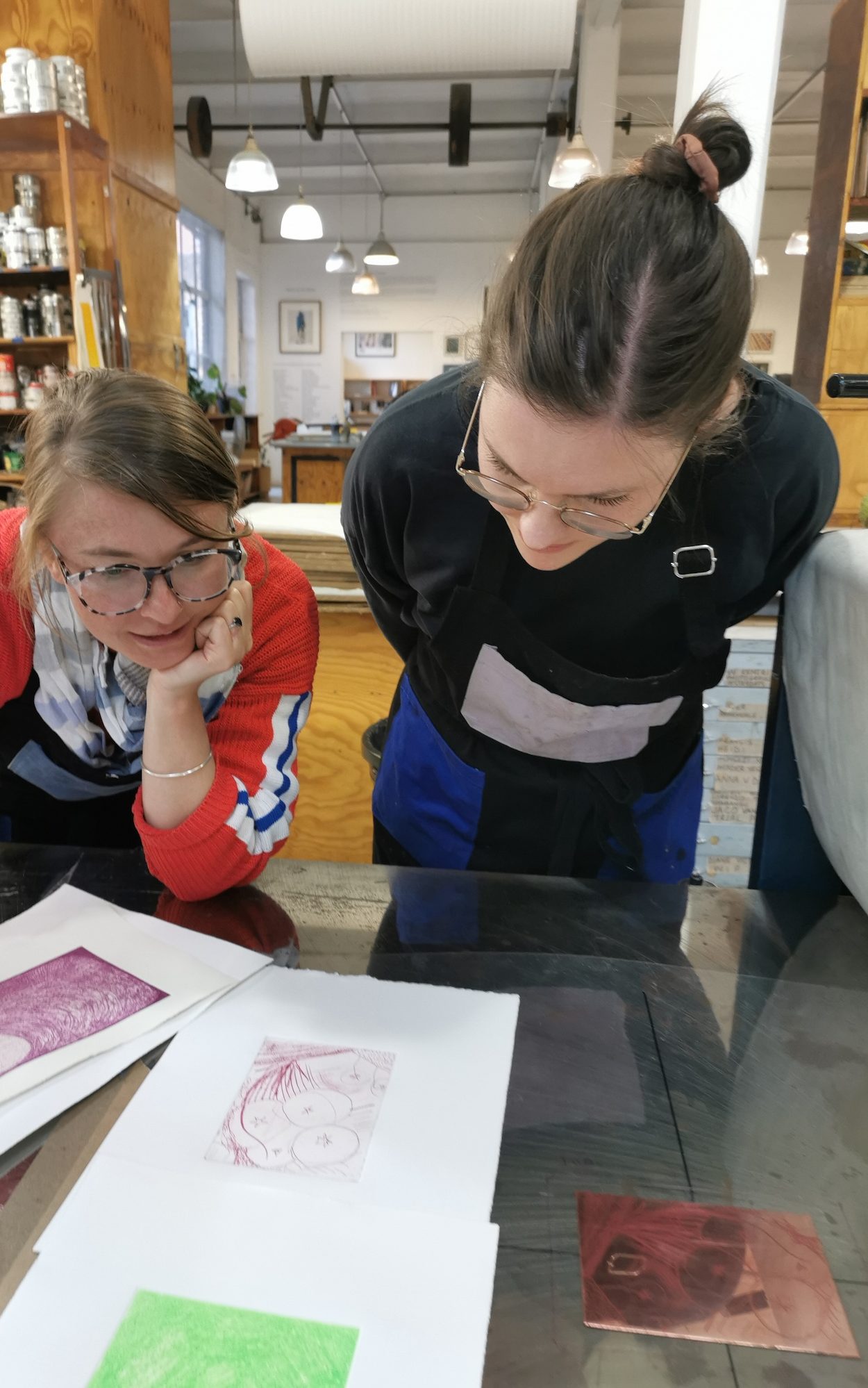
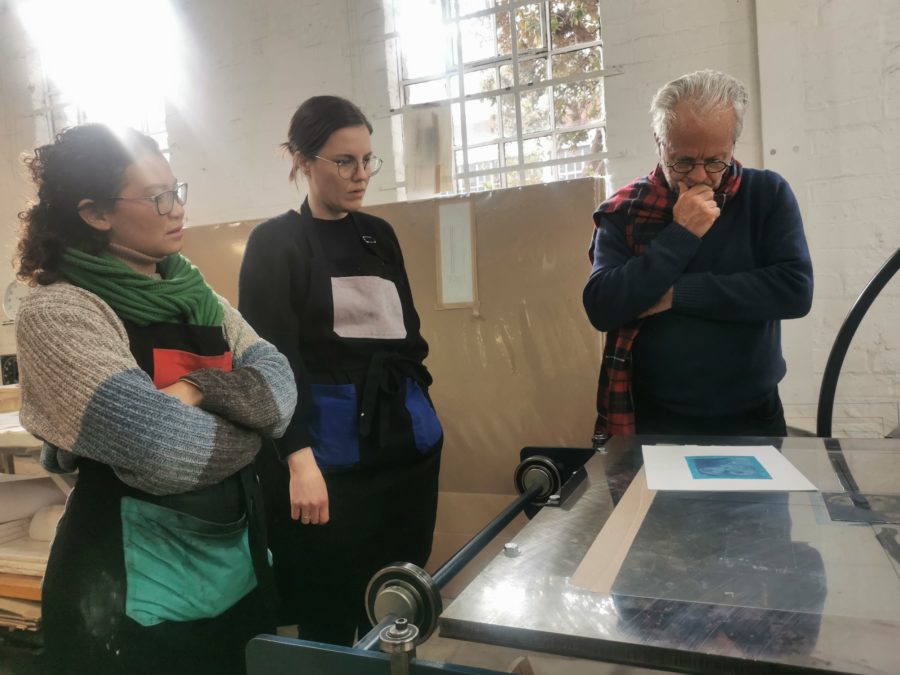

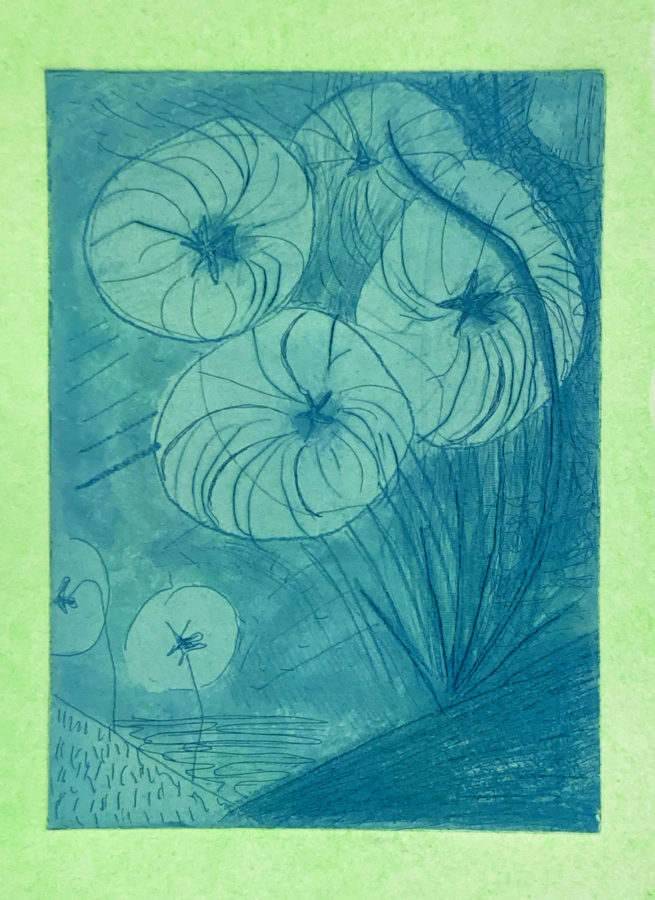
Printer’s Notes and Staying Organized: Throughout my month at DKW, Sarah showed me ways the printers at DKW keep organized and archive the decisions made during the editioning process. One of my favorite organizational tools was the “Printer’s Notes” log detailing every decision made during a print project. The notes describe the pressure of the press, type and number of blankets used, paper weight and colors, ink color and modifier recipes, and much more. These precise and detailed notes help ensure continuity and consistency during the editioning process and archive the printshop’s history in detail.
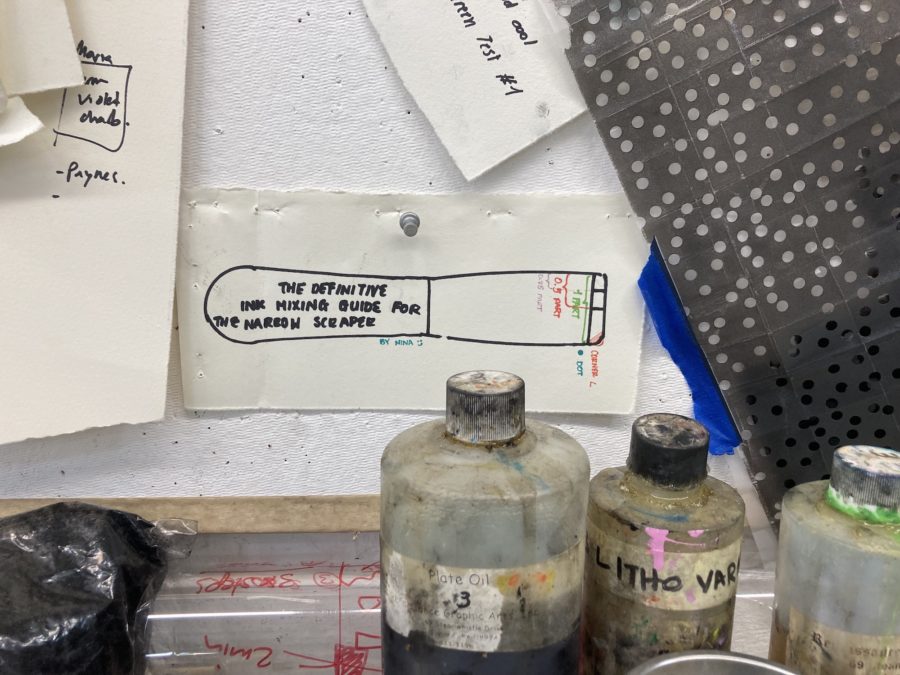
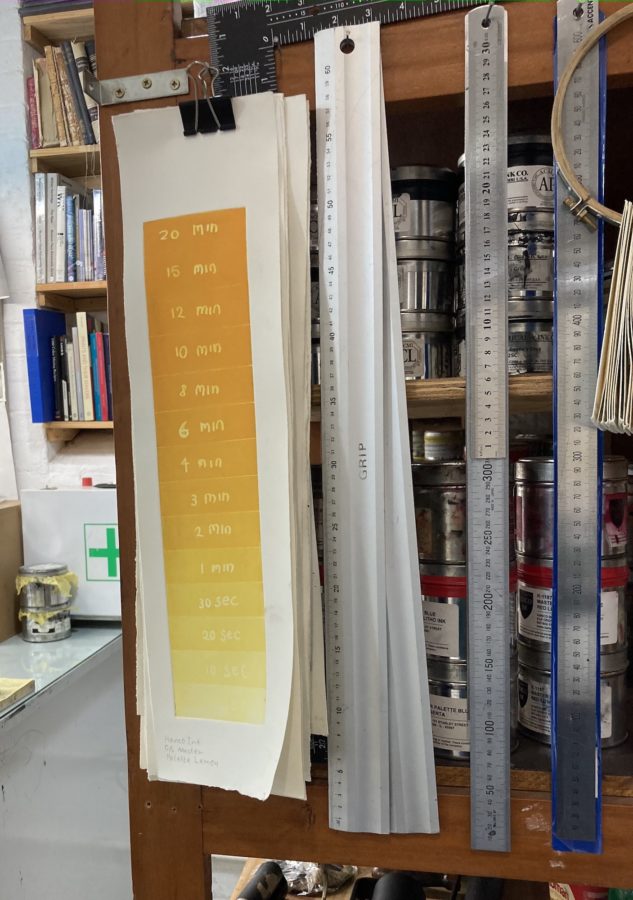
A few of my other favorite organizational tools at DKW are a drawing made by DKW Print Assistant Nina Jacobson detailing the measurements used to mix inks, the catalogue of draw-down ink colors at DKW, and the aquatint step-tests printed in multiple colors. I am looking forward to making my own versions of these tools when I get back to Iowa.
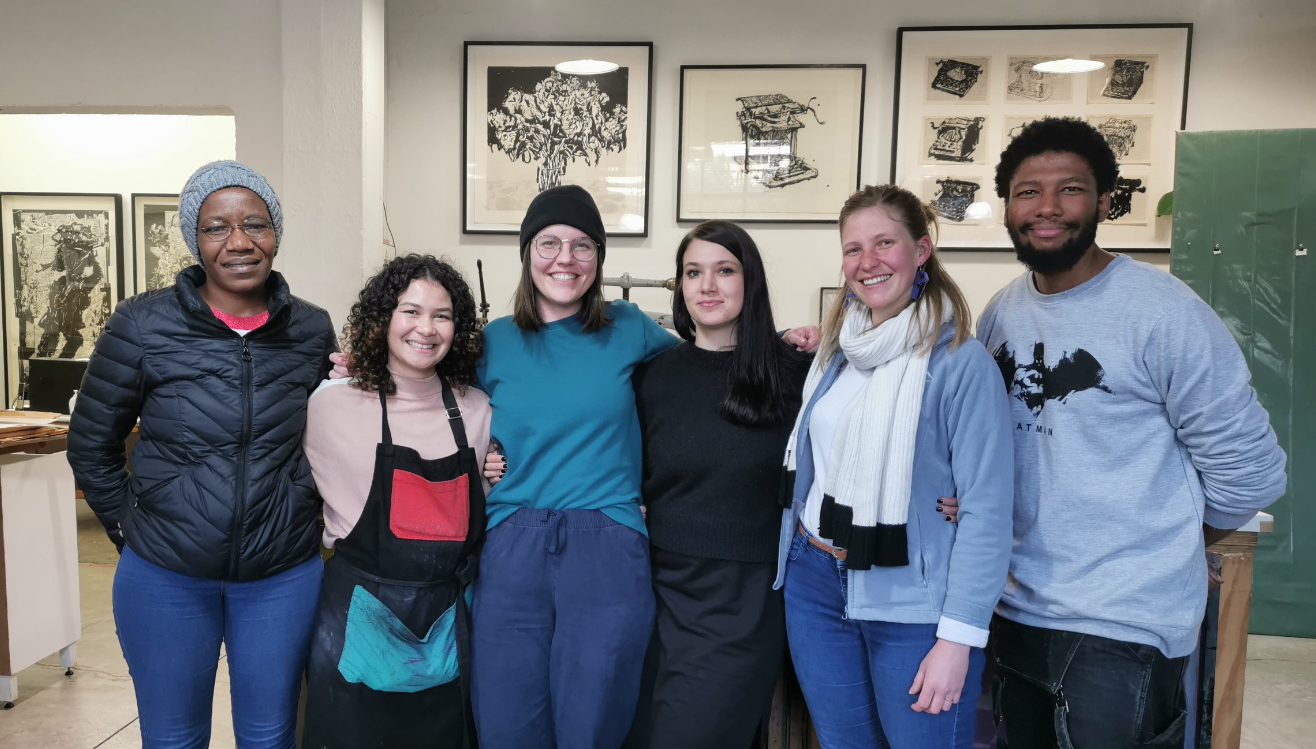
Siphiwe, Kim-Lee, Lauren, Ame, Sarah, and Sbongiseni on Lauren’s last day at DKW
My month at DKW was a joyful experience. I could not have imagined the amount of new knowledge I would leave with or the kindness and patience of the whole DKW team. A huge thank you to David, Ame, Sarah, Sbongiseni, Roxy, Siphiwe, Kim-Lee, and Clementine for all of your support leading up to and through my time at DKW. The opportunity to work with and learn from all of you during my residency is something I will never forget and I know I will reference often. I am immensely grateful for my time at the David Krut Workshop and the support of the University of Iowa’s Stanley Award for International Research Fellowship, which made my stay in Johannesburg possible. Thank you!